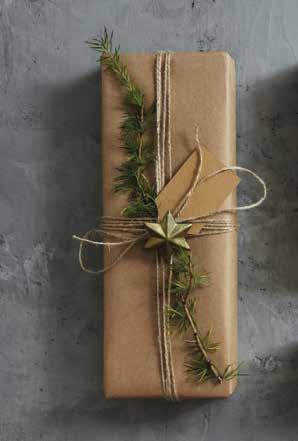
10 minute read
Home Design: Gifts
HOME DESIGN
Gifts That Keep on Giving
By Janice F. Booth
Like every other event and occasion over the last nine months, the holidays will look and feel quite different this year for most of us. With that in mind, I have been thinking of ways we can apply our love of nature and gardens to the joyful task of devising gifts for neighbors, friends, and family.
I’m proposing, dear reader, that the most appreciated gifts this Holiday season may very well be the gifts that “keep on giving,” the gifts that are alive. No, I’m not talking CHIA PETS here, though they can be lots of fun, too. I’m not proposing you pass out puppies or parakeets to friends and family. Rather, I’m thinking of plants and seeds that will engage their new owners and provide days, weeks, months, and, if they’re lucky, even years of pleasure.
So, what are some of the issues you’ll need to consider before preparing your flora gift list?
First, think about delivery: • Will you present the gift in person, leave it on the doorstep? or, • Will you be sending the gift by mail?
Second, what do you know about the person receiving the plant? • Health issues: Does the person have allergies? Breathing problems? • Time issues: Does she/he have lots of time to fuss with a plant? Is his/her schedule always packed? Does she/he need only carefree plants? • Household issues: Does she/he have lots of space to give over to plants? Are there lots of windows and sunlight available? Are there small children who might be curious and interested in a plant? Are there pets that might be tempted to taste or play with a plant?
Third, what is the depth of the recipient’s knowledge of and interest in plants? • Does he/she have plants already? • Is she/he a gardener, experienced with plants? • Will he/she enjoy acquainting him/herself with a new type of plant and its particular requirements? The idea, of course, is for the gift to be fun for the recipient.
Once you’ve reviewed your list of those for whom a plant will be appropriate, you’ll be ready to move ahead with the fun part—selecting plants or future-plants for your family and friends.
For our purposes, let’s consider two categories of plant gifts: • Future-plants, namely seeds/sprouters and bulbs, appropriate for mailing. • Living plants of various types, appropriate for personal delivery.
Consider future-plants for friends and relatives who are far away, too far for you to deliver a gift in person. Seeds and bulbs are also ideal for children and for those who may have restricted mobility. Watching seeds sprout and grow and watching bulbs produce roots, stems, and blossoms can be exciting and great fun…if you have time to watch and note the changes that come with each passing day and week.
Seeds/Sprouters: It’s fun to give a gift of sproutable salad fixings—a salad-in-abox. Lettuce, chives, radishes, turnips, broccoli, kale, and beans are great choices. They’ll grow from seeds easily and quickly. Pictures can be taken, measurements too. If sunlight is hard to come by, a desk lamp or growing light will do. In a pinch, your seedkit could serve as a science project for home schoolers. Think about making up a cleverly packaged 4-part growing kit for the seeds. You can start with simple (1) cardboard egg cartoons for planting seeds. Or, you can buy specially designed growing boxes at the hardware store. While you’re there, pick up some (2) potting soil. (You can make up small zip-bags of soil sufficient for the project.) You may be able to get the (3) seeds there too; but if they’re not carrying seeds in December, you can quickly order them on-line.
Okay, the most important and fun part of the “kit” will be (4) your Growing Guide or note, explaining which seeds are included and a step-by-step guide for preparing the seeds and watching them grow. (Harvesting the plants will be self-evident, we’ll hope.) Use the personal “guide” as a way to make the gift special for the person(s) receiving the kit. Have fun. Draw pictures or paste in cut-outs from magazines or the web. Be sure to give some idea as to how long it will take the seeds to sprout, grow, and be ready for harvesting. Don’t be afraid to be creative with your Growing Guide.
Bulbs: There are several colorful and fragrant bulbs that can be shipped and take well to being “forced” to bloom indoors, during the winter. Think about mixing a group of Tulips, Crocuses, Daffodils, Amaryllis, and Paper White bulbs. Or, simply send one bulb, plump with the promise of springtime ahead. (Choose bulbs that are plump and firm. The size of the bulb will depend upon the size of the bloom it produces; thus, a Crocus bulb is much smaller than an Amaryllis.) The gift of a bulb is a way to engage your friend or relative in a project with you. You can plan to occasionally phone or email with an inquiry as to the progress of the bulb’s growth. She/he will have the double gift of the lovely flower(s) and the contact from you.
Now, for bulbs, your “kit” will be a bit different. Since you’re mailing this, I would suggest the water and pebbles approach to growing rather than planting the bulbs in soil. Your kit will include a (1) low, flat vase or bowl of a circumference that leaves room for the number of bulbs you’ll include and deep enough to half-submerge the bulbs in water. You’ll need enough (2) tiny pebbles to cover the bottom of the bowl and halfway up the bulb; mail them in a zip-bag. (3) Pack the bulb(s) in soft tissue to protect them in transit. Then, write your (4) Guide Book note. Again, make it personal, fitting the person who’ll receive your

gift. Be sure to explain that they’ll need to add water to the bulbs half-buried in pebbles. Give them an idea as to how long it will take for the bulbs to sprout, grow, and bloom. Pictures will be welcome, I’m sure. Have fun personalizing the guide.
And now for the local gifts. These will require less “prepwork,” but more thought. You have lots of choices of plants that will make lovely, treasured gifts. Go back to those three considerations: health, time, and household and review your gift list, make notes as needed. If you enjoyed making up the plant-kits, you can certainly prepare similar kits for personal delivery. They’ll still be fun and special.
But you may want to give your friend an established plant—perhaps something rather exotic or significant to him/her. For example a pretty, sky-blue Forget-MeNot plant. With any plant you give, two things will make the gift memorable. First, the pot in which the plant arrives. The (1) flowerpot should reflect the style and tastes of the person receiving the gift. They’ll notice! Second, the (2) personalized Growing Guide. Yes, living plants need explanation too. There are the obvious hints about amounts of light, fertilizer, and water. Add comments about blooming (if the plant does so) and issues such as pinching back stems and removing dead blossoms. Include a few words telling the recipient why you chose this plant for her/him. The plant will be an extension of you, of your thoughtfulness. (This is an excellent project for children too. They can give plants to their friends and write and draw their own Growing Guides. They’ll learn a bit about botany and about their friendships.)
Let’s begin with the Easy-Care plants:
• Air Plants: These frothy ferns seem to grow on air alone. They can be “potted” in anything, a baby shoe or seashell. They only need occasional misting to thrive.
• Succulents: Chicks-andHens, Jade and Aloe are tried-and-true choices. They’re slow-growing, with plump, green leaves. Succulents need sunlight but little water. (Think desert plants.) Aloe’s long, slender leaves can be pinched off, slit open, and the moist, inner substance applied to cuts, scrapes, and burns to relieve pain and help with healing. (I’ve used-up many a poor aloe applying its healing sap for family first-aid.)
• Lucky Bamboo: Three to four stalks of bamboo in a tall jar or vase filled with pebbles and water will grow for years. They’re lovely for an elegant, minimalist look.
• Peace Lily: Beautiful, glossy leaves and elegant, white blooms twice a year make this plant a favorite gift. In addition to being fairly hardy, indoors, they do a fine job of absorbing toxins in the air, cleansing and freshening any room. They’re a member of the philodendron family, not lilies, so they’re pretty easy to maintain.
• Philodendron: These green or green-and-yellow vines are fun and easy to maintain. They need little attention, and the vines can be trained around a tiny trellis or pinched off and rooted in the soil for even thicker growth. Fun for folks who have no confidence in their gardening skills.
• Snake Plant: These old-fashioned favorites are quiet fellows. Long, thick, variegated leaves grow from a central base and curve as they grow upward. They seem to live oblivious to their surroundings—ideal for someone who wants no fuss or bother, but might enjoy the look of elegant greenery in foyer or bathroom.
Onward to the plants that may be a bit more demanding:
• Orchids: Elegant, varied in colors and sizes, orchids are lovely to give and to enjoy in your home. They have a reputation, and rightly so in my view, of demanding quite a bit of attention and care. I won’t go into the specifics here, but this is a perfect gift for someone who likes to really learn about things, get to know everything about a topic. He/she will have great fun getting acquainted with a beautiful orchid.
• Goldfish Plant: These delightful plants have shiny leaves and gold-orange blossoms (goldfish like, some say.) They’re African Violets, so they too can be particular about their care, but if you get it right, a Goldfish plant will charm you with its cheery blossoms throughout the winter.
• Ferns: If you’re a fern lover, you know they’re a bit particular about their surroundings. But, ferns are so varied in form and lush in appearance, they are stunning additions to a room. The Boston and Maidenhair


Ferns are the most familiar. They were very popular before the advent of central heating because they enjoy a chilly room, as long as there are no drafts. So, friends who keep their homes chilly will have great success with ferns.
• Spider Plants: These are wonderful plants for hanging baskets. There is green or green-yellow variegated leaves and sprays of stems with tiny spider plant babies at their ends. The effect is somewhat like a fountain spray or fireworks of new life exploding from the heart of the mother plant. Great fun to snip off the babies and root them in water for later replanting. Soon, there will be a family of spider plants to give away.
There are many other suitable plants for giving, of course. These are only a few of the most common and reliable choices.
After you’ve devised, packed, wrapped, and delivered your gifts, sit back and enjoy the delighted responses from those who received your thoughtful, living gifts. Psychology Today notes that one of the most valuable gifts is the gift of experiences. If we can’t be together to share experiences, the gift of a living plant can allow us to share the experiences of the garden remotely.













